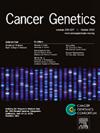Metformin regulates ferroptosis in Skin cutaneous melanoma via ATF3/NRF2 axis
IF 2.1
4区 医学
Q4 GENETICS & HEREDITY
引用次数: 0
Abstract
Background
To explore the effects of metformin on the proliferation and ferroptosis of skin cutaneous melanoma (SKCM) and its potential molecular mechanisms, providing a new theoretical basis and strategy for the treatment of cutaneous melanoma.
Methods
The CCK-8 experiment was used to detect the effect of metformin on the proliferation of skin cutaneous melanoma cells. Kits were used to detect glutathione (GSH) content, reactive oxygen species (ROS), lipid peroxide (LPO), and malondialdehyde (MDA) levels to evaluate ferroptosis-related indicators. RNA-seq sequencing and related analyses were used to screen differentially expressed genes and explore their involved biological functions and signaling pathways. Western blot was used to detect the expression levels of ATF3 and NRF2 proteins and analyze the regulatory effect of metformin on the ATF3/NRF2 axis.
Results
Metformin significantly reduced the proliferation ability of skin cutaneous melanoma cells. The treated cells showed a decrease in GSH content and an accumulation of ROS, LPO, and MDA, suggesting that ferroptosis was regulated. RNA-seq analysis found 2068 differentially expressed genes, of which 897 were up-regulated and 1171 were down-regulated. The related pathways such as iron metabolism disorders and ferroptosis were activated. After metformin treatment, the expression of ATF3 mRNA in cells increased and was positively correlated with the concentration, while the expression in SKCM tissues decreased. At the same time, the expression of ATF3 protein increased and the expression of NRF2 protein decreased, suggesting that metformin may induce ferroptosis through the ATF3/NRF2 axis.
Conclusion
Metformin can induce ferroptosis by regulating ATF3/NRF2 axis, which may be a novel strategy for improving the treatment of skin cutaneous melanoma.
二甲双胍通过ATF3/NRF2轴调控皮肤黑色素瘤的铁下垂
背景探讨二甲双胍对皮肤黑色素瘤(skin skin melanoma, SKCM)增殖和铁上落的影响及其可能的分子机制,为皮肤黑色素瘤的治疗提供新的理论依据和策略。方法采用CCK-8实验检测二甲双胍对皮肤黑色素瘤细胞增殖的影响。采用试剂盒检测谷胱甘肽(GSH)含量、活性氧(ROS)、过氧化脂质(LPO)和丙二醛(MDA)水平,评价铁中毒相关指标。采用RNA-seq测序及相关分析筛选差异表达基因,探讨其相关生物学功能和信号通路。Western blot检测ATF3和NRF2蛋白的表达水平,分析二甲双胍对ATF3/NRF2轴的调控作用。结果二甲双胍显著降低皮肤黑色素瘤细胞的增殖能力。处理后的细胞GSH含量下降,ROS、LPO和MDA积累,表明铁下垂受到调节。RNA-seq分析发现2068个差异表达基因,其中上调897个,下调1171个。铁代谢紊乱、铁下垂等相关通路被激活。二甲双胍处理后,细胞中ATF3 mRNA的表达增加,且与浓度呈正相关,而SKCM组织中表达减少。同时,ATF3蛋白表达升高,NRF2蛋白表达降低,提示二甲双胍可能通过ATF3/NRF2轴诱导铁下垂。结论二甲双胍可通过调节ATF3/NRF2轴诱导铁下垂,可能是改善皮肤黑色素瘤治疗的新策略。
本文章由计算机程序翻译,如有差异,请以英文原文为准。
求助全文
约1分钟内获得全文
求助全文
来源期刊

Cancer Genetics
ONCOLOGY-GENETICS & HEREDITY
CiteScore
3.20
自引率
5.30%
发文量
167
审稿时长
27 days
期刊介绍:
The aim of Cancer Genetics is to publish high quality scientific papers on the cellular, genetic and molecular aspects of cancer, including cancer predisposition and clinical diagnostic applications. Specific areas of interest include descriptions of new chromosomal, molecular or epigenetic alterations in benign and malignant diseases; novel laboratory approaches for identification and characterization of chromosomal rearrangements or genomic alterations in cancer cells; correlation of genetic changes with pathology and clinical presentation; and the molecular genetics of cancer predisposition. To reach a basic science and clinical multidisciplinary audience, we welcome original full-length articles, reviews, meeting summaries, brief reports, and letters to the editor.
 求助内容:
求助内容: 应助结果提醒方式:
应助结果提醒方式:


